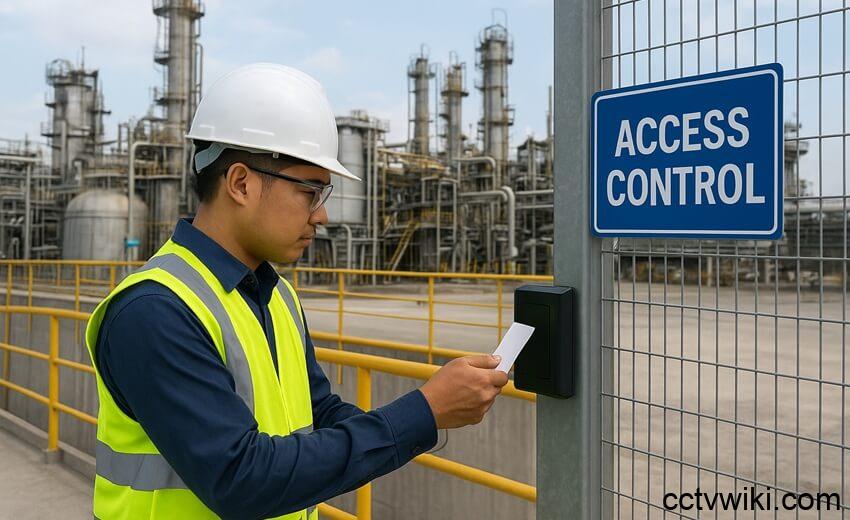Securing the Factory Floor: How Access Control Protects Industrial Sites
Industrial sites, the heart of manufacturing and production, face a unique set of security and safety challenges. From sprawling factories to intricate manufacturing plants, these facilities require robust protection for both their workforce and the valuable assets within. That’s where access control systems come into play, offering a comprehensive solution for safeguarding industrial environments.
But what exactly needs protecting? Industrial sites are treasure troves of vital resources, including:
Key Assets at Risk
* Equipment and machinery: Think CNC machines humming away, powerful presses shaping materials, turbines generating energy, and conveyor systems orchestrating the flow of goods. Heavy-duty equipment like forklifts, cranes, and trucks also play a critical role.
* Materials and inventory: Raw materials like metals, chemicals, fuels, wood, and plastics are the lifeblood of production. Partially assembled goods, finished products, and ready-to-ship inventory all represent significant value.
* Technology and control systems: Sophisticated industrial control systems (ICS) like SCADA and HMI panels, along with IoT sensors monitoring pressure, flow, vibration, and temperature, are essential for efficient operations.
How Access Control Can Help
Securing these critical assets and the people who manage them is no easy feat. Thankfully, modern access control solutions offer a powerful toolkit for industrial site administrators.
“Industrial sites are complex environments with high-value assets, strict safety regulations, and large, dynamic workforces,” explains Prabhuraj Patil, Senior Director for Physical Access Control Solutions, ASEAN and India Subcontinent, at HID. “Operators face challenges such as securing hazardous areas, preventing unauthorized access, and ensuring smooth movement of staff, contractors, and visitors without creating bottlenecks. Modern access control solutions address these challenges by providing scalable, intelligent, and role-based security frameworks.”
Patil emphasizes the importance of tailored access: “Access rights can be tailored to specific job functions, ensuring only trained and authorized personnel enter sensitive areas, thereby reducing both security and safety risks. By combining robust physical security with digital identity management, operators gain better visibility into site operations, enhance accountability, and reduce the likelihood of incidents that could disrupt productivity or regulatory compliance.”
Justin Wilmas, EVP of Sales at Acre Security, agrees. “Protecting specialized equipment, safeguarding production data, and ensuring only the right people have access to restricted areas are daily challenges,” he says. “In the access control sector, our role is to provide systems that give operators the confidence to manage these risks without slowing down operations. Role-based access, live monitoring, and hazard alerts help keep operations moving – safely and efficiently. Just as importantly, our systems scale with growth and integrate easily, strengthening security as operations evolve.”
Areas Where Access Control Excels
Access control systems offer benefits across multiple facets of industrial site management:
Security/Occupational Safety
Protecting workers and assets is paramount. “Industrial facilities face escalating cyber and physical threats, with attacks on manufacturing increasing by 105 percent in recent years,” notes Hanchul Kim, CEO of Suprema. “Access control prevents unauthorized entry and protects critical zones. During emergencies, instant visibility into personnel locations can mean the difference between life and death.” Kim adds that Suprema’s AI-powered platform delivers predictive security intelligence, identifying threats before they materialize.
Patil further emphasizes the safety aspect: “Restricting access to hazardous environments only to certified personnel helps prevent accidents. Integration with safety training databases can ensure compliance before access is granted.”
Regulatory Compliance
Industrial sites operate under a web of regulations, and access control systems help ensure adherence.
“Industrial sites face strict regulations such as US’s OSHA (Occupational Safety and Health Administration) and Korea’s Serious Accident Punishment Act. Modern access control systems complied with GDPR, NIS2 and so on, provide audit-ready logs, and time-stamped entry/exit records, and credential management workflows for contractors and visitors, simplifying compliance reporting,” Kim explains.
Operational Efficiency
Efficiency is key to productivity, and access control can play a significant role. “Modern industrial operations demand precision timing and workforce optimization,” Kim says. “Our integrated time and attendance functionality delivers ROI through accurate labor tracking, reducing payroll discrepancies while enabling real-time workforce analytics.”

